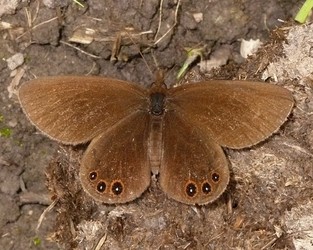Idioneurula
Andrew V. Z. Brower


This tree diagram shows the relationships between several groups of organisms.
The root of the current tree connects the organisms featured in this tree to their containing group and the rest of the Tree of Life. The basal branching point in the tree represents the ancestor of the other groups in the tree. This ancestor diversified over time into several descendent subgroups, which are represented as internal nodes and terminal taxa to the right.

You can click on the root to travel down the Tree of Life all the way to the root of all Life, and you can click on the names of descendent subgroups to travel up the Tree of Life all the way to individual species.
For more information on ToL tree formatting, please see Interpreting the Tree or Classification. To learn more about phylogenetic trees, please visit our Phylogenetic Biology pages.
close boxIntroduction
This high-elevation genus from the Colombian Andes contains several recently-described species, and has lately been revised by Huertas and Arias (2007).
References
Huertas, B. & Arias, J. J. 2007 A new butterfly species from the Colombian Andes and a review of the taxonomy of the genera Idioneurula Strand, 1932 and Tamania Pyrcz, 1995 (Lepidoptera: Nymphalidae: Satyrinae). Zootaxa 1652, 27-40.
Lamas, G. (ed.) 2004 Atlas of Neotropical Lepidoptera. Checklist: Part 4A Hesperioidea - Papiionoidea. Gainesville: Scientific Publishers/Association of Tropical Lepidoptera.
Pyrcz TW. 1995. A new genus, Tamania, and a new species, Tamania jacquelinae, from the Tama Range, Venezuela Colombia border, and some thoughts on the diagnosis of the tribe Pronophilini (Lepidoptera: Nymphalidae: Satyrinae). Lambillionea 95: 519-525.
Pyrcz, T. W. & Viloria, A. L. 2007 Erebiine and pronophiline butterflies of the Serrania de Pama, Venezuela - Colombia border (Lepidoptera: Nymphalidae: Satyrinae). Tropical Lepidoptera 15, 18-52.
Information on the Internet
Nature Online: Idioneurula donegani. Natural History Museum LondonTitle Illustrations

| Scientific Name | Idioneurula erebioides |
|---|---|
| Location | COLOMBIA: Boyaca, Rogitamo-Arcobuco |
| Comments | Rogitama- Arcabuco, Boyaca, Colombia 8/19/2010--70121 |
| Specimen Condition | Live Specimen |
| Identified By | Kim Garwood |
| Life Cycle Stage | adult |
| View | dorsal |
| Source | Idioneurula erebioides |
| Source Collection | Flickr |
| Copyright | © 2010 Mike Chapman |
About This Page

Middle Tennessee State University, Murfreesboro, Tennessee, USA
Correspondence regarding this page should be directed to Andrew V. Z. Brower at
Page copyright © 2011
 Page: Tree of Life
Idioneurula .
Authored by
Andrew V. Z. Brower.
The TEXT of this page is licensed under the
Creative Commons Attribution License - Version 3.0. Note that images and other media
featured on this page are each governed by their own license, and they may or may not be available
for reuse. Click on an image or a media link to access the media data window, which provides the
relevant licensing information. For the general terms and conditions of ToL material reuse and
redistribution, please see the Tree of Life Copyright
Policies.
Page: Tree of Life
Idioneurula .
Authored by
Andrew V. Z. Brower.
The TEXT of this page is licensed under the
Creative Commons Attribution License - Version 3.0. Note that images and other media
featured on this page are each governed by their own license, and they may or may not be available
for reuse. Click on an image or a media link to access the media data window, which provides the
relevant licensing information. For the general terms and conditions of ToL material reuse and
redistribution, please see the Tree of Life Copyright
Policies.
- First online 01 November 2006
- Content changed 24 July 2011
Citing this page:
Brower, Andrew V. Z. 2011. Idioneurula . Version 24 July 2011 (under construction). http://tolweb.org/Idioneurula/82850/2011.07.24 in The Tree of Life Web Project, http://tolweb.org/







 Go to quick links
Go to quick search
Go to navigation for this section of the ToL site
Go to detailed links for the ToL site
Go to quick links
Go to quick search
Go to navigation for this section of the ToL site
Go to detailed links for the ToL site